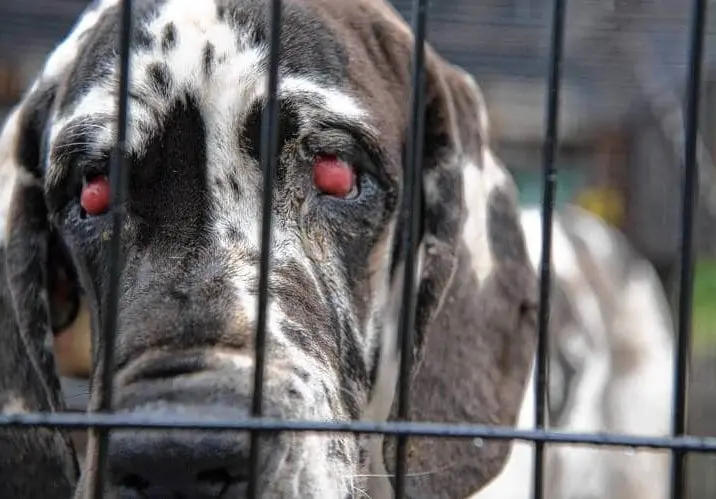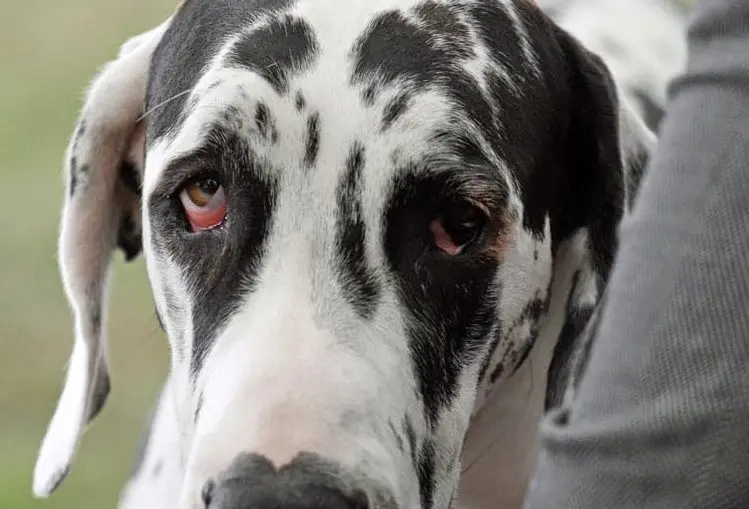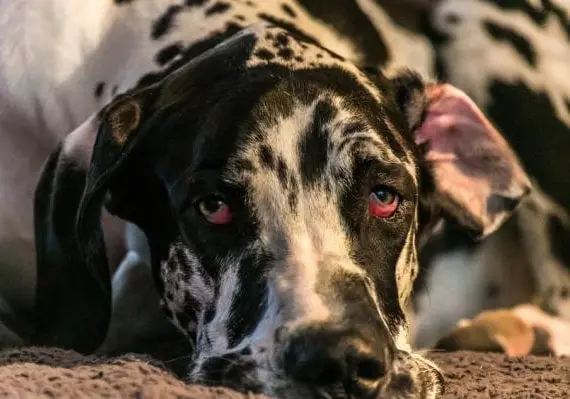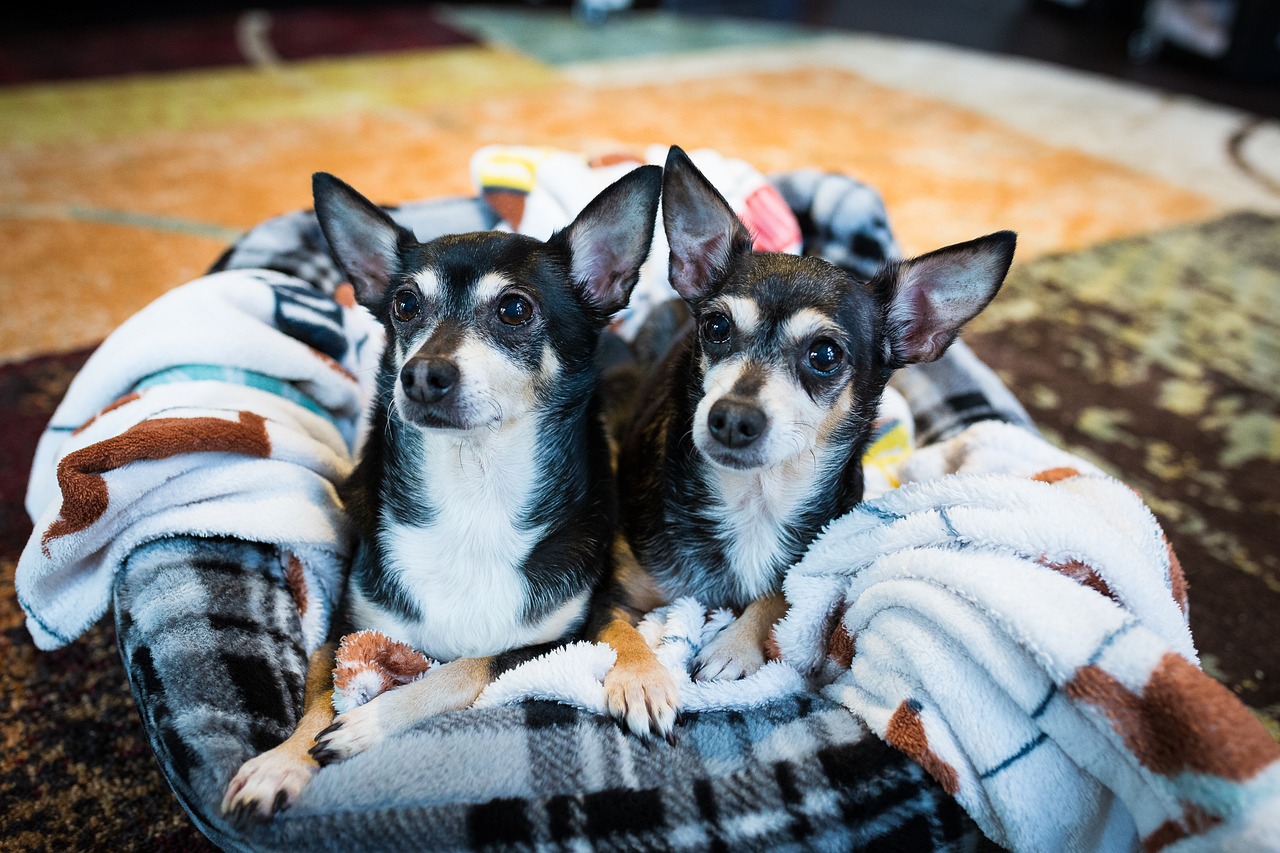You might notice your Great Dane’s Eyes red. Well, this condition is common in dogs. But sagging eyes are harmful to any dog breed, including Great Danes. Tight eyelids are essential to maintain Great Dane’s eye health. The skin around the eyes prevents dirt or debris, so your dog sees everything properly.
Eyelids also save against other severe infections. Breeds like Great Danes are sensitive to developing sagging, drooping, or red eyes. Even though, Great Danes might not need frequent baths like other dogs, maintaining skin hygiene can be significant over time.
After a long day of playing or between baths, you’ll likely see mucus building up around your Great Dane’s eyes. Don’t worry; clean it using a warm, wet towel to keep their eyelid clean and healthy and avoid blocking their view.
So, if you observe that your dog’s eyes are turning red or drooping, it could be due to aging. Although red eyes are also symptoms of irritation, infection, or disease such as entropion, glaucoma, ectropion, and cataracts. Thus, keep reading to discover more.
Is it Normal for Great Dane’s Eyes Red?
Your Great Danes can get red eyes for several reasons, such as a foreign object in the eye, dry eye, injury, allergies, infections, conjunctivitis, and glaucoma. If your Great Danes has red eyes, you can take care of it at home. But if the eye condition is severe, take him to the vet clinic.
What is Ectropion, and How does it Occur?

Ectropion is a medical condition in which the lower eyelid of Great Danes starts to sag and roll out of the eyeball. This exhibit the eye’s mucus to debris, bacteria, or dirt from the surroundings and cause infections. This condition starts in one eye but can spread to both eyes. It is a noticeable condition due to sagging red eyes.
Ectropion is mainly caused by selective breeding. Since it is a genetic disease, it is easy to stop and does not spread to other pups. Dog owners must not choose the dog breeds that show ectropion; over time, the condition will completely disappear.
This disease is most likely in dogs with loose skin around their faces. If your Great Danes parent has sagging or drooping eyes, then there are also chances of ectropion in your pup.
What are the Symptoms of Ectropion?
A significant symptom of ectropion is swollen eyes with lower eyelids. If the lower eyelid does not touch the eyeball, the eyes become red and drooping. Other symptoms are excessive tearing. The eye discharge makes the eyelid heavy and it begins to sag. If the eyelid rolls out too much from the eyes, it can cause more problems.
The ectropion symptoms appear in Great Danes puppies at an early age. But sometimes the symptoms develop in older age, such as after exercise or a long snooze on wood. So, always keep an eye on your Great Danes and observe any changes.
Treatment of Ectropion
So far, there is no persistent treatment for ectropion. If your Great Dane has been discovered with this disease, you can manage it in different ways. When you visit the veterinarian, the vet prescribes an ointment to prevent pain and prevent eyes from drying
Surgery is a good option if your Great Danes undergo frequent eye infections. Actually, it’s a pup facelifting. If you observe your Great Danes have ectropion symptoms, consult with your veterinarian. It is essential to handle these signs as soon as possible to prevent them from worsening.
What is Entropion, and How does it Occur?

A medical condition in which a dog’s eyelid roll inside is known as Entropion. It can happen on the upper or lower eyelid or even on the eye’s side. In this disease, Great Dane’s eyelid and eyelashes rub against each other, causing inflammation to the cornea. This situation causes chronic ulcers and aching cross-eyes.
You can feel the pain of your Dane; for instance, it is excruciating if one eyelash pokes into your eye. So, just imagine an eyelid rubbing against the eyeball. Damn! That’s painful. This disease is mainly found in young growing Great Danes. Types of entropion are as follows:
Inherited Entropion
It is the most common type of entropion and occurs in dog breeds with loose skin on the face, such as Great Danes, bulls, Shar-peis, and chows.
Acquired Entropion
In this type of entropion, Great Dane’s eyelid rolls inside due to muscle changes around the eyes. This condition shrinks the eyeball and starts to pour into the nose. Typically, it founded in older dogs and pups with eye problems.
Spastic Entropion
This type is triggered by muscle cramps causing the eyelid to irritate the eyes. It can happen due to other eye problems, such as your Great Dane experiencing a corneal ulcer. Also, this disease can occur in any dog breed at any age.
What are the Symptoms of Entropion?
The symptoms of entropion include:
- Excessive blinking eyes
- Cuts on the cornea
- Eye tics
- Tearing eyes
- Pawing at the eyes
- Redness
When this condition worsens, a brown pigment develops on the cornea. If Great Danes fiddle with their eyes and seem uncomfortable, it might be a symptom of entropion. So, consult your veterinarian for immediate medication.
Treatment of Entropion
Luckily, entropion can be treated in dogs. Veterinarians offer options for medication, such as ointments or eye drops. These soothe the pain and protect the eyes from rubbing. Tapping the eyelids temporarily can prevent the Great Dane puppy from outgrowing the entropion as its skull develops.
The Great Danes might have to undergo the procedure a few times, but once the eyelids are adjusted, the stitches can be removed. Sometimes, Great Danes puppies never exceed the entropion, and surgery is needed to maintain and position the eyes correctly.
If entropion is left untreated, it can cause vision distortion due to tears and cornea cutting. So, proper care is essential to ensure your Great Danes have visual and healthy eyes.
What is Glaucoma and How does it Occur?

Glaucoma is the most detectable red eye disease in dogs. Sadly, this painful genetic condition is common in Great Danes. This condition occurs when the eye’s liquid cannot flow out or move properly, which causes excessive internal pressure. It can cause changes in the eye’s function and structure. Two types of Glaucoma are as follows:
Primary Glaucoma
Primary glaucoma is convenient to anticipate because it is a genetic condition that can harm a healthy eye. So, it is necessary to examine the eyes to spot the symptoms and start treatment immediately.
Secondary Glaucoma
It occurs due to eye injuries or other diseases. This condition can provoke tumors, blood clots, inflammation, infection, or damage to the lens.
Symptoms of Glaucoma
A checkup might be essential if you notice Great Danes pawing or scratching their eyes. The common symptoms of glaucoma include:
- Constant squinting
- Blinking
- Swollen eyes
- Blur cornea
- Excessive tear
- Blurry eyesight
- Eyes drooping
- Redness in the white part of the eye (Sclera)
Treatment of Glaucoma
It can be treated if you catch early glaucoma symptoms in your Great Dane. Usually, the veterinarian will prescribe medication to lessen the fluid pressure in the eye to prevent discomfort and pain. Treating glaucoma includes a regular visit to the veterinarian to ensure healthy eyesight and observe eye pressure.
In severe conditions, surgery is required to relieve the pressure. If the surgery or medicine does not cure the affected eye or blindness has occurred, removing the eye might alleviate the pain.
What are Cataracts, and How does it Occur?

In this condition, the dog’s lens is covered with an opaque layer or cloudiness on the lens that can cause blurry vision. If a cloudy texture covers the eye lens, it stops the light from going into the retina, which causes vision loss. A bilateral or juvenile cataract can happen in dogs. As juvenile cataracts are genetic, so it occurs at the age of 6 months.
Bilateral cataracts develop in Great Danes due to aging or other diseases such as diabetes, nutritional disorders, glaucoma, eye injuries, and inflammation.
Symptoms of Cataracts
Cataracts are a continuing disease that gets worsens day by day. The earlier you cure this disease, the better it is. If your Great Dane’s eyes start to squint, appear red or are bloodshot, then consult the veterinarian immediately. Other symptoms are vision loss, not recognizing faces, cloudiness on the eye lens, and bumping into walls.
Treatment of Cataracts
The most common treatment for cataracts is surgery. In this surgery, the lens is removed and replaced by an artificial one. Although, the surgery is risky and very costly. Also, it requires a specialized dog eye doctor or veterinary ophthalmologist.
If surgical treatment is not an option, the dog owners normally keep their pets or Great Danes surrounding familiar. They rely solely on touch and noise to communicate with them.
Other Reasons for Red Eyes in Great Danes
Red eyes in Great Danes can also occur due to other different reasons. Common causes include dry eyes, allergies, foreign objects in the eye, or an injury. Sometimes red eyes are not to be worried about, but some conditions may require immediate medication.
Corneal Ulceration
The cornea is the membrane in the front of the eye. If a foreign object enters the Great Dane’s eyes, your dog will keep pawing and scratching the cornea, which allows the bacteria to attack the eyes. This way, the cornea will dissolve and is very painful. You will see mucky discharge, severe blinking, and scratching at the eye of your Danes.
In corneal ulceration, your pooch needs quick veterinary medication. In rare cases, dreadful bacteria can cause an ulcer on the dog’s cornea within 24 hours. In this situation, antibiotics are useful to save your Dane vision.
Environmental Irritant
Many potential irritants live in or out of the houses that can cause red eyes in Great Danes. Smoke, cleaning products, and dust can cause severe infection in your dog’s eyes. If you observe bloodshot in Great Dane’s eyes, contact a veterinarian before the eyes worsen.
Conjunctivitis
Conjunctivitis is caused by an infection in the eyes. In this condition, the membrane covered the eyelids inside. Many treatments are available for conjunctivitis. Also, it depends on the causes, ranging from allergies, infections, or injury.
Dry Eyes
If your Great Dane’s eyes are not producing enough moisture to lubricate them properly, it is due to dry eyes. If the tear glands become try, the cornea becomes dry too. That makes the eyes red and inflamed. So, visit the vet to treat this condition.
Allergies
If your Great Danes have allergies, they might suffer eye inflammation, redness, scratching, itchiness, and face rubbing. The sclera and conjunctiva can become swollen, irritated, and red. The sclera is the eyeball’s white part, and the conjunctiva is the tissues inside and outside the eyelid.
Great Danes will develop severe allergies and can lose eyelashes. Treating allergies is challenging, so consult a holistic veterinarian for this condition.
Uveitis
The whole eye inflammation is known as Uveitis. It is uncommon and caused by comprehensive disease or infection. This condition is harrowing, and your Great Danes must avoid bright light. The infection causes are:
- Parasitic diseases such as ehrlichiosis and Toxoplasmosis
- Fungal diseases such as histoplasmosis, coccidioidomycosis, blastomycosis, and cryptococcosis
- Virus diseases such as distemper and rabies
- Bacterial diseases such as leptospirosis and Lyme disease
- Metabolic diseases such as high blood pressure and diabetes
So, take help from the veterinarian to figure out the issues. The medication will be severe in case of bacterial infection and get better in a week. If it’s a virus disease such as distemper, it can be a serious issue. Also, the Great Dane’s eye will be better in case of fungal infection.
Cherry Eye
A condition in which the dog’s third eyelid gland is affected is a cherry eye. The gland becomes red and swollen in this condition. The exact reason for the cherry eye is not apparent. Also, sometimes the treatment of this eye condition is surgery.
Eye Injuries
If your Great Danes hit your eye while playing, you might notice these symptoms:
- Redness of tissues over the eye
- Tears coming from the eye after hitting
- Swelling eyelid
- Redness of the white part of the eyeball (sclera)
- Frequent squinting after knock
Your Great Danes will recover quickly if the corneal is not damaged. The eye will be normal in 24 hours. But if the injury is severe, take your Danes to the veterinarian immediately.
How do you tell if your Great Danes has Eye Infection or Allergies?
If you notice your Great Danes eye redness, watery discharge, blinking, light sensitivity, swelling, squinting, holding the eye closed, and pawing the eyes. It’s an eye infection or allergy. So, in this case, visit the veterinarian first.
FREQUENTLY ASKED QUESTIONS
Why is the White of my Great Danes Red?
The white of your Dane’s eyes is red due to increased inflammation. It leads to redness and makes the blood vessels large on the white part of the eyeball (sclera).
Is it Bad if my Great Dane’s Eyes are Red?
If you notice redness in your Great Dane’s eyes, it might be due to aging. However, red eyes also signal irritation, infection, cataracts, entropion, ectropion, and glaucoma.
Do red Eyes mean Great Danes are Tired?
Sometimes red eyes mean your dog is tired. But still, it can be due to different reasons such as injuries, inflammation, infection, etc.
How can I Soothe my Great Dane’s Red Eyes?
A cold compress is beneficial against inflammation. If your Great Danes has a red itchy eye, take a cold, wet cloth and slightly compress it to the eye. You can purchase hard ice packs or soft cold compresses from nearby pharmacies.
What can I do for my Great Dane’s Red Eyes?
Call the vet to schedule an appointment if Great Dane’s eyes are red. You should provide information about how and when redness occurs. Do not try to treat the redness yourself at home.
Wrapping up
However, Great Danes with red and droopy eyes might look loveable, but you must be aware of health risks. Take extra care of your red-eyed Great Dane while playing outside. Ensure to keep away dirt from your Dane. Also, you must know the Great Dane’s parent’s history of eye problems while purchasing a new puppy.
So, the Great Dane’s eyes are red might be due to the above reasons. I hope you find this article helpful. If you still have a question, comment below. I will answer as soon as I can. Also, please share it with your friends. Thanks!




